2024 Accountability Report
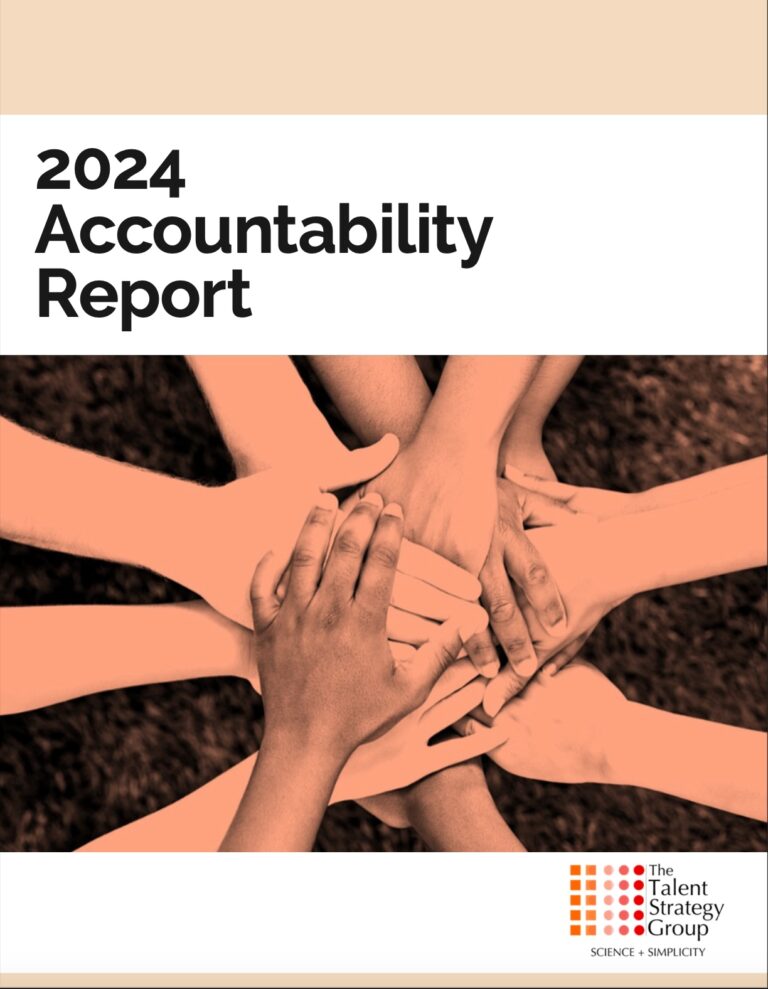
Executive Summary
Our 2024 Accountability Report shows the current and desired level of manager accountability to complete select talent practices. The findings confirmed our expectations based on our client and Talent Management Institute conversations over recent years.
Key Findings
There is little good news in the findings which show that the average level of accountability on every talent practice measured is that “3. A few others know about your success/failure.” Many items had current state accountability at “2. Only you know about your success/failure.” It’s no surprise that talent practices are not consistently executed across industry and geography given that there is little or no consequence (positive or negative) for a manager’s actions.
Larger companies start higher, end similarly
Companies with more than 25,000 employees had an average current state closer to “4. You feel strong, cultural pressure to do/not do something,” while smaller organizations averaged a current state closer to “3. A few others know about your success/failure.” The desired state average for all organizations was very close to “8. You receive meaningfully more or less compensation.”
Goals and engagement have the highest current state accountability
The highest current state average was for “Managers ensuring their team members have high quality (few, challenging) goals” and “Managers increasing engagement or maintaining high engagement” with a “4. You feel strong, cultural pressure to do/not do something.”
Diversity rated lowest, perhaps balanced by inclusion
The lowest current score (2.6) and desired score (6.7) was “Managers building teams that reflect company diversity objectives” with those scores being one full point lower than most other items. However, the related item of “Managers leading in ways that create an inclusive team environment” had both a higher current (3.8) and high desired (7.8) average score.
We provide all the data plus recommend actions in the report.
Performance Management
Managers ensuring their team members have high quality (few, challenging) goals.
It’s a positive surprise that this item is tied for the highest “Current” rating with an average of 4 (You feel strong cultural pressure to do/not do something.” However, it’s also tied for the highest “Desired” ranking with 7.8 (You receive meaningfully more or less compensation), which suggests there’s more work to do.
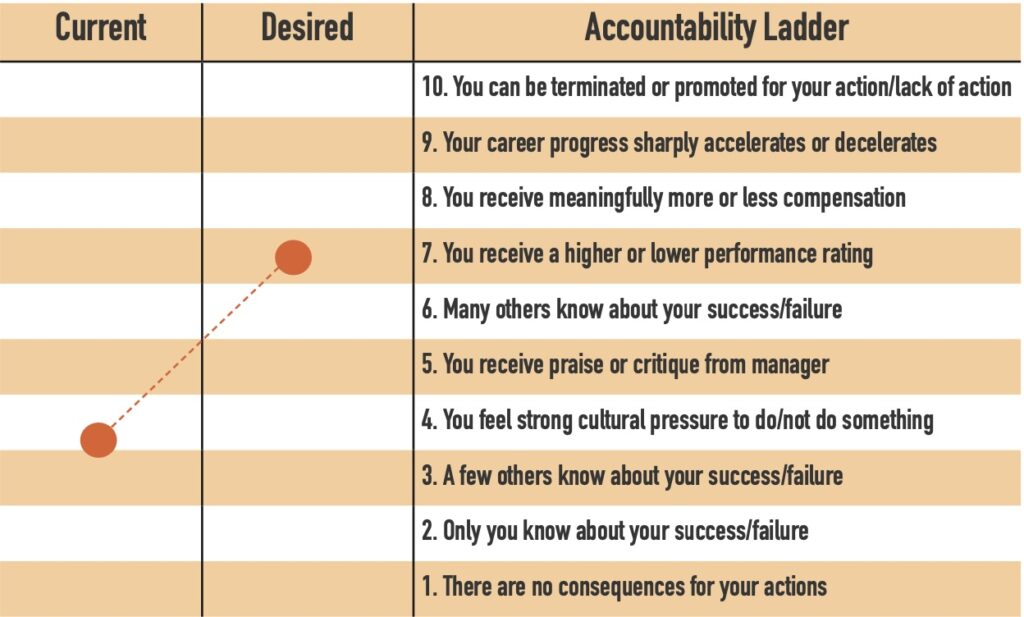
Implications
Organizations are leaving performance “on the table” by not focusing and stretching employees through goals. When either no goals or poorly written goals are set, it pollutes the downstream process of coaching (against what?) and reviewing (how can one accurately measure or compare achievement against others?).
Accountability Recommendations
Great goal setting is the foundation of individual and organizational high performance.
We suggest multiple layers of accountability including:
- The manager of manager reviews goals below them: The manager (L1) of the manager (L2) should review all the goals set at L3. They can quickly assess which goals will contribute to the L1 objectives and provide feedback to L2 leaders about which goals need to be adjusted.
- HRBP reviews goals: HRBPs should be both business experts and goal setting experts. They should review the goals of 20% – 30% of the team they’re responsible and provide the goal setting with suggestions in two areas. First, if a goal isn’t clearly aligned to the business or function objectives, they should suggest how to better align it. Second, if the goal is not written properly (vague, non-measurable, etc.) they should suggest how to rewrite the goal to make it clear and measurable.
Additional resource: Setting Great Goals: Fewer, Better, Stronger
Managers having regular (at least quarterly) transparent coaching conversations with each direct report
One of the lowest ranked “Current” items at 2.9 (A few others will know about your success/failure), this result reflects what we see in our clients globally. Despite making process changes like quarterly conversations or adding tech to enable easier feedback, you say that even these infrequent conversations are still not occurring.
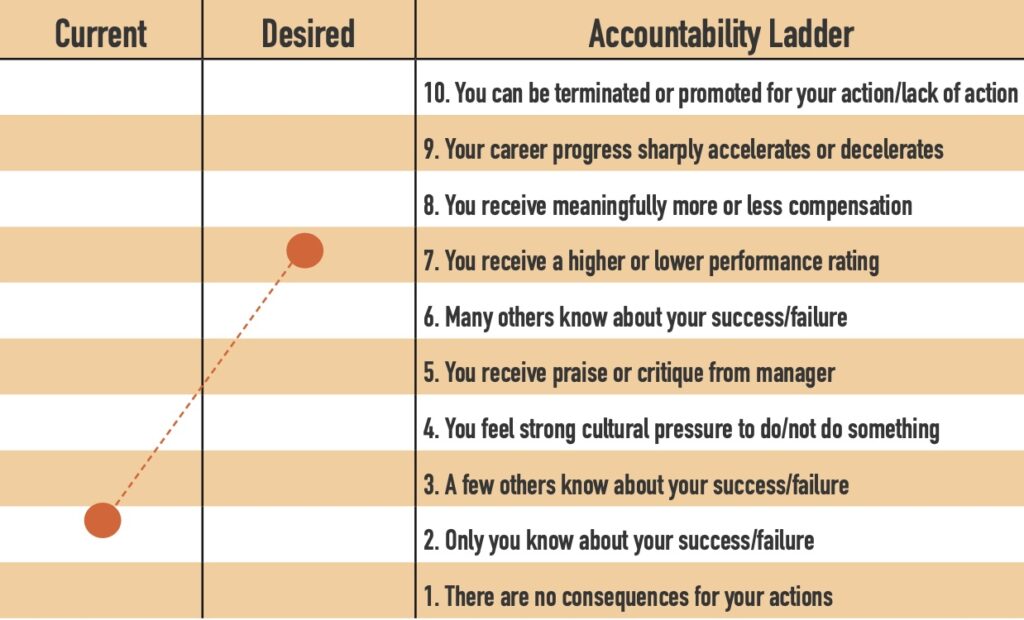
Implications
When employees don’t get regular guidance on how to elevate their performance or behaviors, they won’t make necessary changes and won’t get reinforcement when they achieve results. They don’t have the opportunity to perform at their highest potential.
Accountability Recommendations
Performance and behavior coaching is something that managers often feel uncomfortable doing. They may also be biased towards their team members and genuinely believe that slipping performance or suboptimal behaviors aren’t that consequential.
We suggest measuring if these conversations are happening with a simple, one question survey. This one question is sent to every direct report at least annually and ideally quarterly. The questions asks, “Have you had a quality coaching conversation with your manager in the last 90 days?” The answer choices are “Yes” and “No.”
The results of that question go to the manager’s manager, who can use that as data to recognize or coach the manager.
Additional resource: 2+2 Coaching video
Development
Managers ensuring every high potential leader on their team has a high quality development plan.
One of the lowest rated items at 2.8 and an item with the 2nd largest gap between the Desired state and Current State (nearly 5 points), failure on this item increases your organization’s performance and succession risks. While not every employee needs a development plan, it’s essential that you understand how and when your top talent will grow.
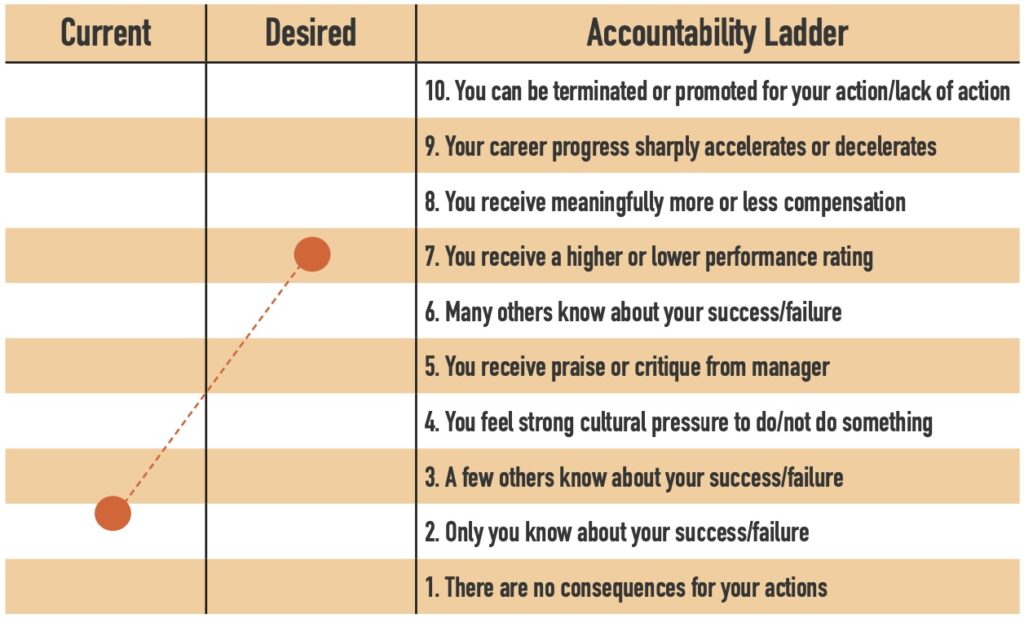
Implications
Your best talent should be on a well-crafted Talent Production Line that methodically moves them through the experiences that will best accelerate their development. That movement is the ultimate accountability of their manager, but the VP, Talent, the HRBP and potentially the CHRO all share that accountability.
Accountability Recommendations
- Every high potential and high performer has a 70/20/10 development plan: Our 2024 High Performer and High Potential Development Report found that development plans are surprisingly rare for organizations’ best talent. In 83% of companies, less than half of high performers have a development plans. In 75% of companies, less than half of high potentials have one.
Everyone rated as a high performer or high potential in your talent review process (or other process that identifies this talent) must have a development plan primarily focused on experiences. HRBPs and the talent management team should collectively support line managers in creating these plans.
The talent management team is ultimately accountable for the quality of these plans, at least it’s senior levels. This means they must read through each plan and determine if it makes the standard of a high-quality plan or requires specific adjustments that they can recommend to the HRV and the individuals line manager.
Our philosophy is that high potentials and high formers are not accountable for their own development. The organization, and specifically their manager, are accountable to ensure these individuals become more skilled and more capable every single year. The individual is accountable to participate in the plan development and to execute it successfully.
Additional resource: Delusions of Employee Development
Managers having a clear development conversation with every direct report every year.
With one of the smaller gaps between the current and desired states, a clear development conversation with every direct report every year seems like a very attainable state. Our experience with clients globally is that this conversation rarely occurs and is of little consequence when it does.
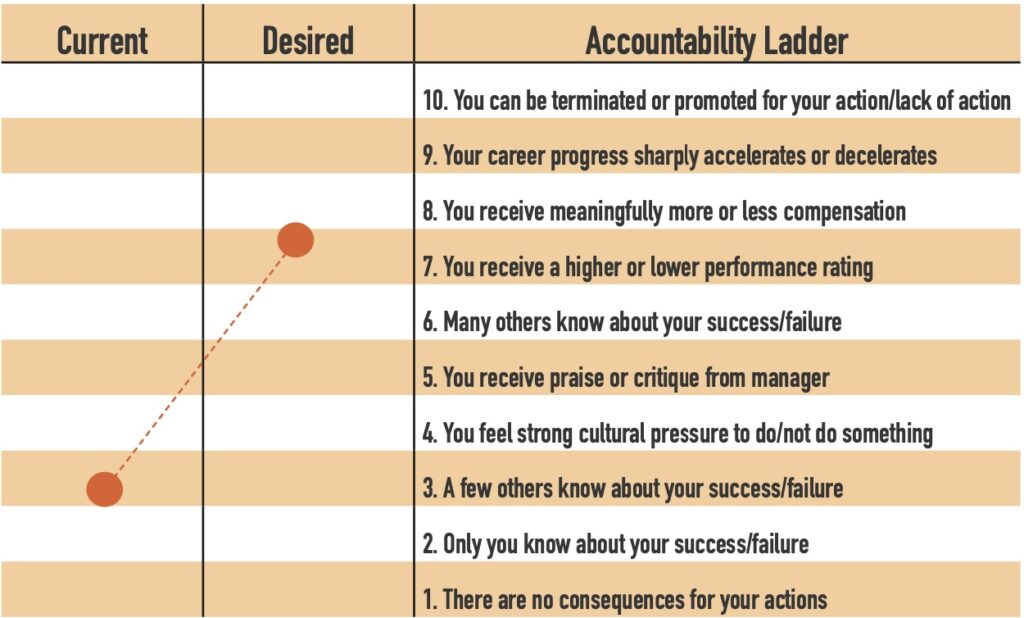
Implications
The perceived ability to develop and grow in one’s career is a consistent driver of engagement around the world. Most organizations have either it requirement or a strong suggestion that development conversations held annually. The absence of, or lack of quality in, these conversations, lower engagements, increase shirking, and elevate turnover.
Accountability Recommendations
The steps mentioned in the previous section help ensure that high performers and high potentials get these conversations. We can do two things to help managers have these conversations with all other employees on a more frequent basis and in a more helpful way.
- Tell employees about the process: Be clear with employees that it is their people manager’s responsibility to have at least a yearly, formal conversation about how they can be an even better performer or elevate their behaviors. It’s important to share that this is not necessarily a career growth conversation, but a conversation about how they can be an even better performer in their current job This creates what we call “embarrassment-based accountability” – your manager should be embarrassed if they don’t do it — which is a very powerful tactic with many people!
- Integrate “one thing” to performance goal setting: Instead of coming up with a classic development plan, ask every people manager to speak with each employee about how they can improve this year’s performance. We find a radically simple way for the people manager to identify that one development item is to ask them to complete this sentence, “This direct report can be an even better performer this year if they…”
The answer may be a new behavior, skill, stopping an activity or any other step that would allow the individual to better develop against their goals. That sentence becomes the development objective – not recorded or measured – but agreed to with the employee. Career development conversations should follow talent reviews.
Employees actively pursuing the development goals set for them.
While we want every employee to grow every year, we reject the facile mantra that “employees own their own development.” As with anyone else, employees need accountability to execute this action.
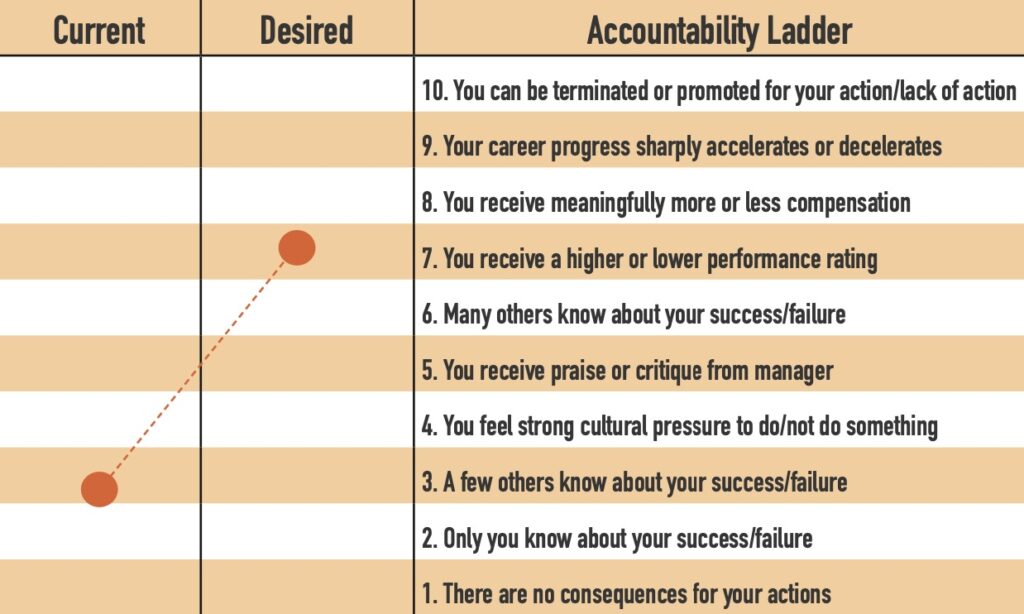
Implications
The logical extension of “employees own their development” is that a small number of self-motivated individuals will improve but most, feeling that they are already good performers, won’t grow at all.
Accountability Recommendations
Employees need to be educated that experiences are the building blocks of their career and know that they must report on their success of their development actions. We suggest two accountability actions:
- Employees “pledge” on development actions: Whether set through the “one thing” method described on page 10 or other discussion, the employee pledges that they will pursue and complete the identified development action. The term “pledge” is specifically used to reinforce that the employee is promising to do this, not “trying hard,” “will get to if they have the time,” etc.
- Employee submits year-end development statement: The employee needs to write a short (1 – 2 paragraph) statement at year-end and submit it to their manager describing the steps and outcomes from their development actions.
Managers annually increasing the overall quality of their direct reports
This item has the largest gap between the Current state and the Desired state. That result isn’t surprising given the low rating given to the current state, which is at the high end of “Only you will know about your success/failure.
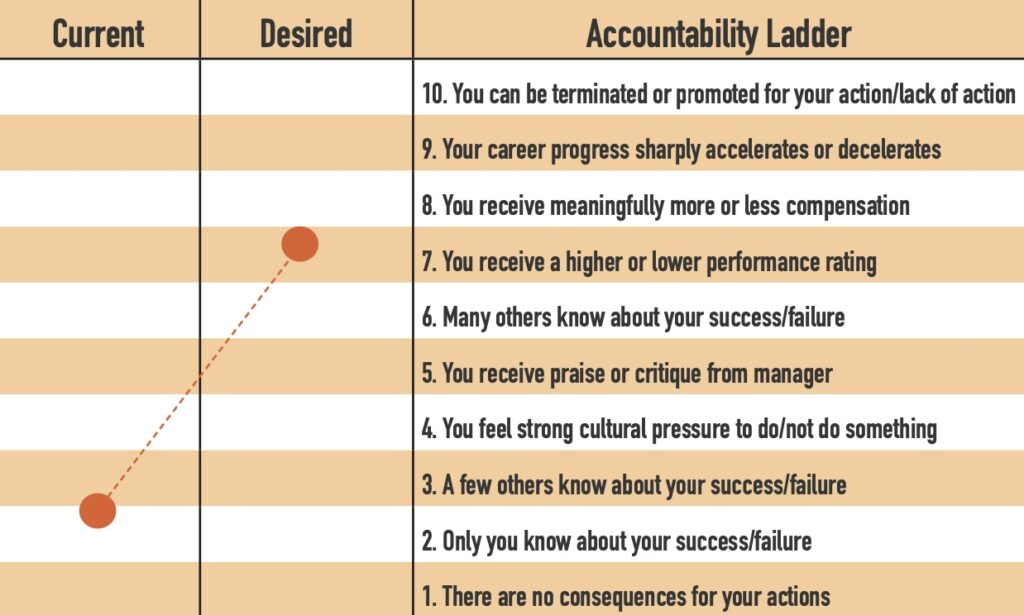
Implications
If we believe that better quality talent delivers better quality results, we should strongly reinforce this element of accountability. Without a hard measure to drive actions, we rely on managers to be both interested in and capable of elevating the quality of their team.
Accountability Recommendations
As we mentioned earlier, we don’t believe that employees are completely accountable for their own development. A key accountability of your people managers should be to increase the quality and depth of their team every year. “Increasing the quality” means that the overall team is better skilled, more capable, better behaved or another valuable outcome by year-end.
Two tactics can increase accountability:
- Manager prepares year-end team quality statement: As part of the year-end review process, people managers need to submit a statement describing how their team has improved that year. It doesn’t need to list every team member, but needs to include specific outcomes that demonstrate individual and/or overall improvement.
An alternative is to incorporate this into talent reviews, if this is a regular and disciplined process in your organization.
- Incorporate into performance evaluation: Either as a part of the overall performance evaluation, or as a stand-alone measure in it, managers should be rated on the improvement of the team. We suggest a three-point scale: 0 for little or no improvement, 1 for minor but noticeable improvement and 2 for significant and likely measurable improvement.
Potential & Succession
Managers accurately rating direct reports’ potential to advance.
Our client experience suggests that it is rare to manage this outcome – a fact borne out by the Current rating on this item. We need to move managers’ accountability in talent reviews from completing the process to accuracy in their assessment.
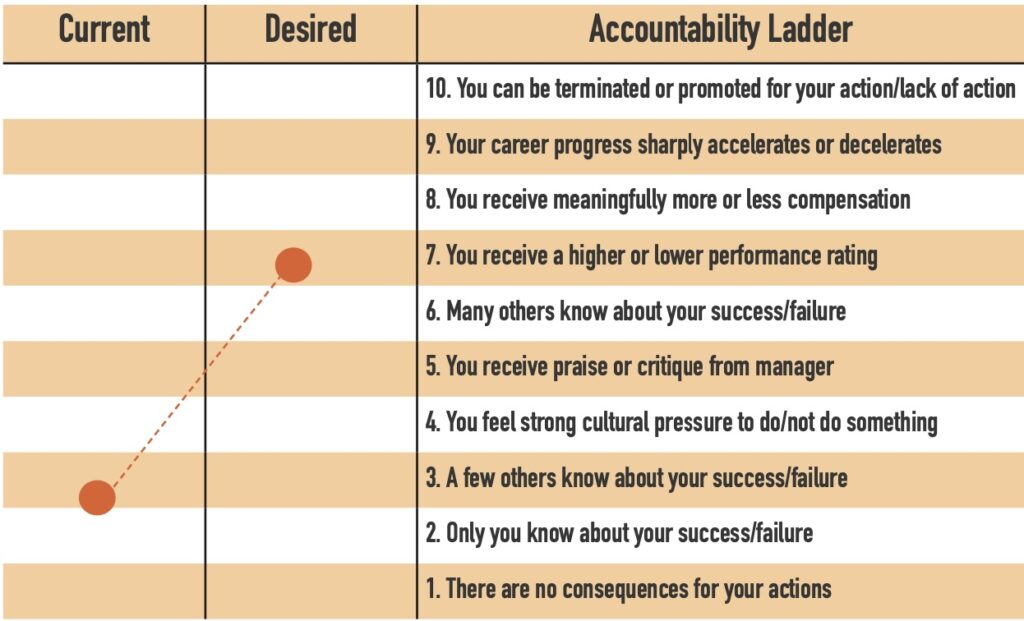
Implications
If managers accurately rate the potential to advance of their direct reports, we can appropriately invest in and plan for their development. Accurate choices ensure that our best talent gets the support they need to grow, while inaccurate choices both waste company resources and send the wrong messages to those who are told they are high potential.
Accountability Recommendations
The challenge with measuring accurately in potential predictions is that it takes time for potential to show. There is one key accountability measure that can be applied in two different ways:
- Actual progress of selections: This measures if the individual is progressing at the pace predicted by the manager:
- Actual movement based on box: Assuming you use some form of performance and potential grid, each year individuals should be compared to their predicted movement. If you say someone can move up a level in 1 – 2 years, after two years, they need to have been promoted. Track and report this statistic by manager.
- Progress based on predicted movement: Predicting movement over 3 – 4 years or longer means that the ultimate measure will take that long. For those rated high potentials (or your fastest movement category), managers need to explain in the talent review discussion how the individual has progressed that year towards that goal.
Additional resource: 4 Secrets to Better Talent Reviews
Managers creating realistic succession plans for key roles
The low Current rating of 2.9 is consistent with our observations that succession planning is too often a paper exercise with no applicability or consequences.
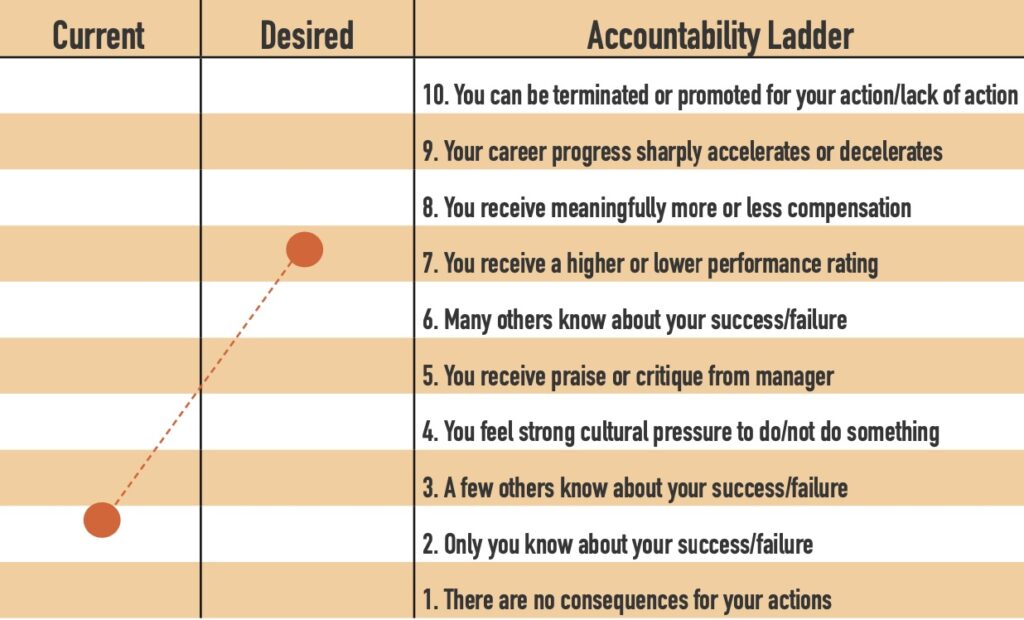
Implications
Succession planning is a risk management exercise and should be taken as seriously as any other action meant to protect the organization. Inaccurate listing of potential successors means that when succession occurs external recruiting will be needed, or sub-optimal internal substitute choices will be made. For more senior roles, gaps in or poor succession choices can cause billion-dollar swings in market capitalization.
Accountability Recommendations
A few different measures can evaluate succession planning accuracy, but unfortunately, they all measure too late to make a difference.
- Actual placement into predicted role: The most straightforward measure of succession accuracy is whether the listed individual(s) gets the role when it becomes open. Again, this is a long-term measure that can only be evaluated after a choice is made. It should be measured and reported by manager on a yearly basis. If the named successor isn’t chosen and external recruiting is required, the fully loaded cost of that external recruitment should also be reported.
- Progress towards “ready”: Many succession plans are graded by how many years away, or roles away, a leader is from “ready now.” Each year progress up that ladder should be evaluated and reported. If someone is 3 – 4 years from being ready, after 2 years they should be 1 – 2 years from being ready. Progress should be measured and reported annually.
Reward & Recognition
Managers recognizing their direct reports’ achievements (outside formal compensation process)
While recognizing the accomplishments of one’s team members seems fundamental to good management, the Desired state is the second-lowest rated. This may reflect that existing processes already support this or that managers naturally engage in this behavior.
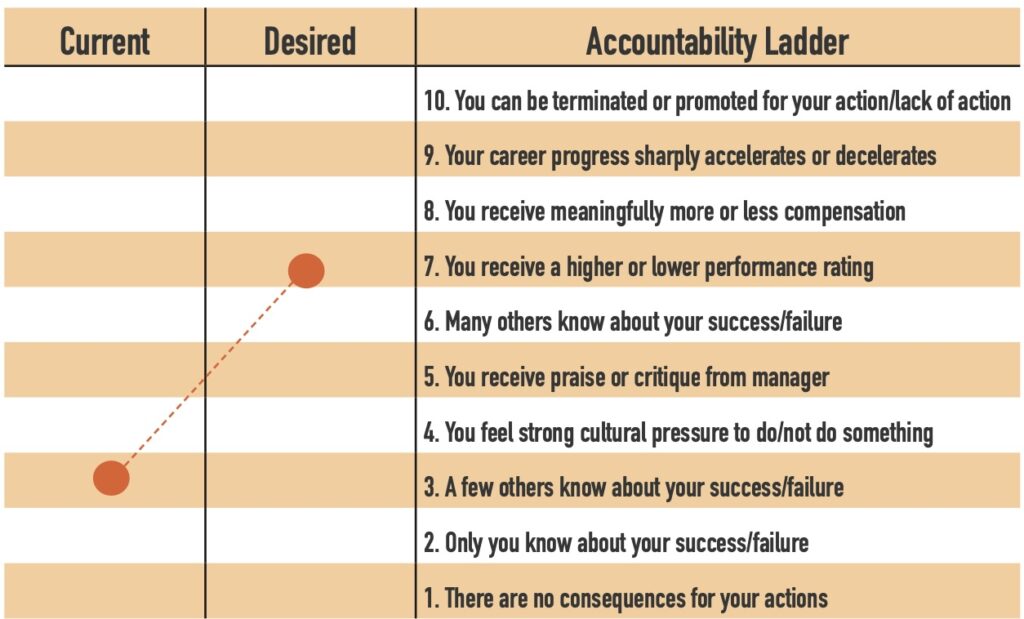
Implications
Recognizing individual or team performance has the well-known benefits of reinforcing performance or behaviors, and through that contributing to engagement. When managers don’t recognize strong achievements, employees may interpret that as managers not caring about the employee’s results or not being willing to acknowledge them.
Accountability Recommendations
This is a “customer” measure, meaning that the truest measure is employee perceptions, but we can add an addition metric as well.
- Perceptions of team recognition: Asking about individual recognition will be heavily biased by the Better than Average Effect, so a less-biased survey question will ask about the manager’s behaviors in general. An item like, “My manager recognizes team members for their achievements,” can produce a more accurate result.
- Use of recognition tools/programs: If your organization has formal recognition tools (spot awards, etc.), measure and report on the frequency with which each manager uses those tools. A yearly measure, adjusted by team size, can provide a more objective assessment.
Manager accurately differentiating compensation based on performance and behaviors
The low Current state measures at 3.1 may reflect our observation that the behavioral measures in performance management are not used to their potential. The average weighting reported in our most recent Performance Management Report between performance and behaviors was 68% performance and 32% behaviors.
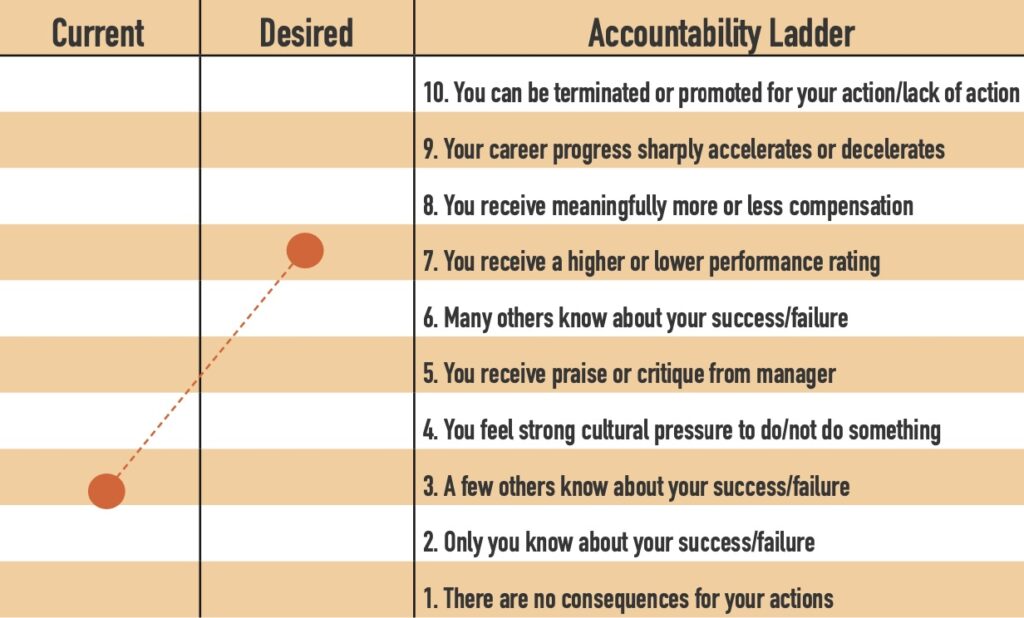
Implications
When managers don’t accurately evaluate behaviors and performance, or inappropriately weight either, then send the wrong measure to the team member and often other team members. If not corrected, managers will learn that the system is toothless and rate team members accordingly.
Accountability Recommendations
We should have a more accurate assessment of an individual’s behaviors when more people observe them and can evaluate them. Making the behavior rating transparent can support a higher quality evaluation at year-end.
- Use split ratings: Having a separate rating for behaviors and for performance provides additional visibility in the rating calibration discussion. The manager can still blend the two into one final rating, but how they arrived at the result is more transparent.
- Hold ratings calibration discussions: A relatively common element of many companies’ year-end process, rating calibration discussions can add value beyond trying to fit ratings into a budget curve. In those discussions, other participants can probe ratings that seem unusually high either for an individual or team.
This is especially valuable when the stated performance/behavior balance is 50/50. Participants can call out managers who don’t appropriately penalize bad behavior or who allow “nice guy/nice gal” behaviors to make up for weaker performance.
Diversity & Inclusion
Managers building teams that reflect company diversity objectives
This question has the lowest Current rating (2.6) and lowest Desired rating (6.7), a full point below the higher rated items. This indicates a lower interest in holding leaders accountable for building diverse teams.
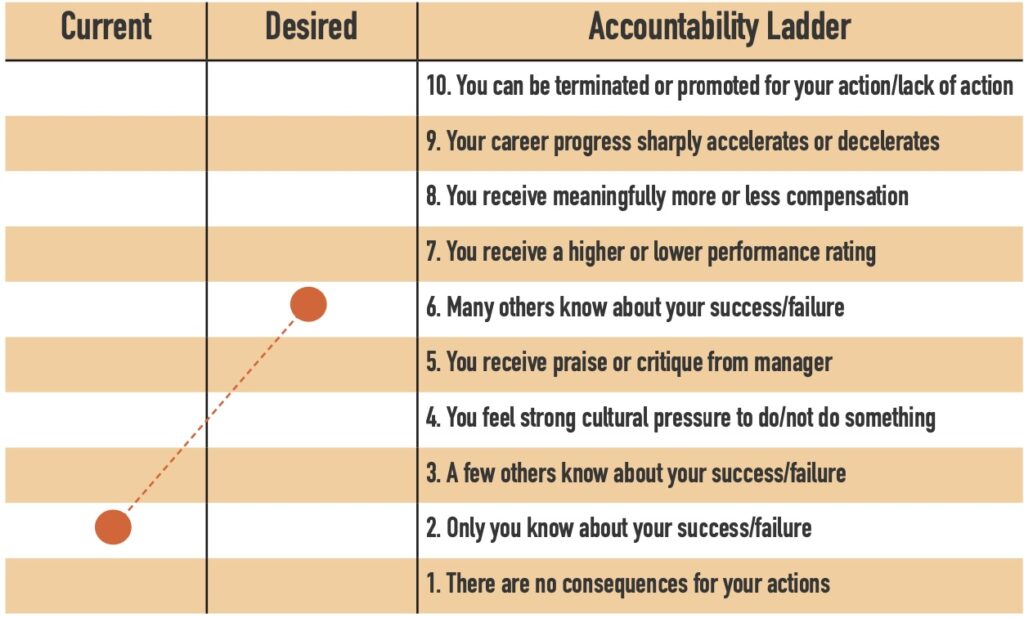
Implications
While the science suggests that diverse leadership teams perform the same as non-diverse teams1, many companies have implicit or explicit goals to increase diversity, especially in senior leadership. This item ranking the lowest of the 13 items asked in this survey suggesting that companies’ stated commitments to diversity may not be as strong as they communicate.
Accountability Recommendations
In the United States, the recent Supreme Court decision on college admissions and subsequent pressure on companies’ demographic diversity practices may influence their willingness to create specific accountability.2 Two accountability tactics may still work to reinforce the desired outcomes to managers.3
- Report on proportional diversity statistics for specific roles: For common roles here the proportion of demographic diversity in the marketplace is known, report how the company’s demographic mix compares to the marketplace mix of qualified candidates. Rank these by function (Legal, IS, Finance, etc.) and report to the executive team annually.
- Extent of diverse recruiting sources used: For select multi-incumbent roles, report on the specific channels used to attract diverse applicants, and the hiring proportion from each.
1 Jacobs, Rose. “Do Diverse Leadership Teams Produce Better Performance?” July 24, 2024, Chicago Booth Review. Retrieved from https://www.chicagobooth.edu/review/do-diverse-leadership-teams-produce-better-performance
2 Goldberg, Emma. Facing Backlash, Some Companies Go “Under the Radar.” New York Times, Retrieved from https://www.nytimes.com/2024/01/22/business/diversity-backlash-fortune-500-companies.html#:~:text=For%20instance%2C%20Armughan%20Ahmad%2C%20the,algorithms.&text=Plenty%20of%20corporate%20leaders%20share,’%E2%80%9D&text=The%20Supreme%20Court’s%20recent%20decision,Rights%20Act%2C%20which%20covers%20contracts.
3 These statements are not suggested as legally valid but as ideas to consider. All actions in this area should be reviewed with your legal advisors before taking action.
Managers leading in ways that create an inclusive team environment
This item’s Desired rank is tied for the highest in the survey. This may help to balance out the lower score on diversity reported in the previous item.
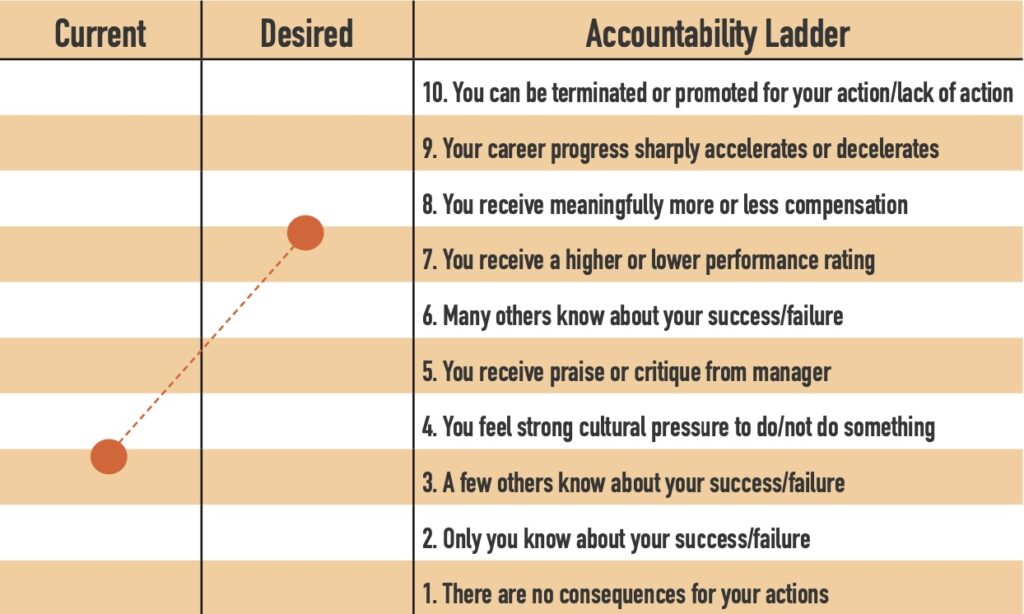
Implications
Inclusion is related to various factors that elevate engagement, satisfaction and psychological safety, so there is at least a weak relationship between inclusion and individual performance. Managers who understand which inclusion behaviors matter and act accordingly should be supporting higher individual performance.
Accountability Recommendations
Accountability for this element is best driven through measures of “customer” perceptions since perfectly objective measures of “inclusion” don’t exist.
- Ask relevant survey questions: We suggest asking either, “My manager encourages all team members to share their ideas and perspectives” or “My manager ensures that everyone’s input is considered when making decisions.”
Engagement
Managers increasing engagement or maintaining high engagement
This item’s Desired rank is tied for the highest in the survey, even though its Current rating is also tied for the highest.
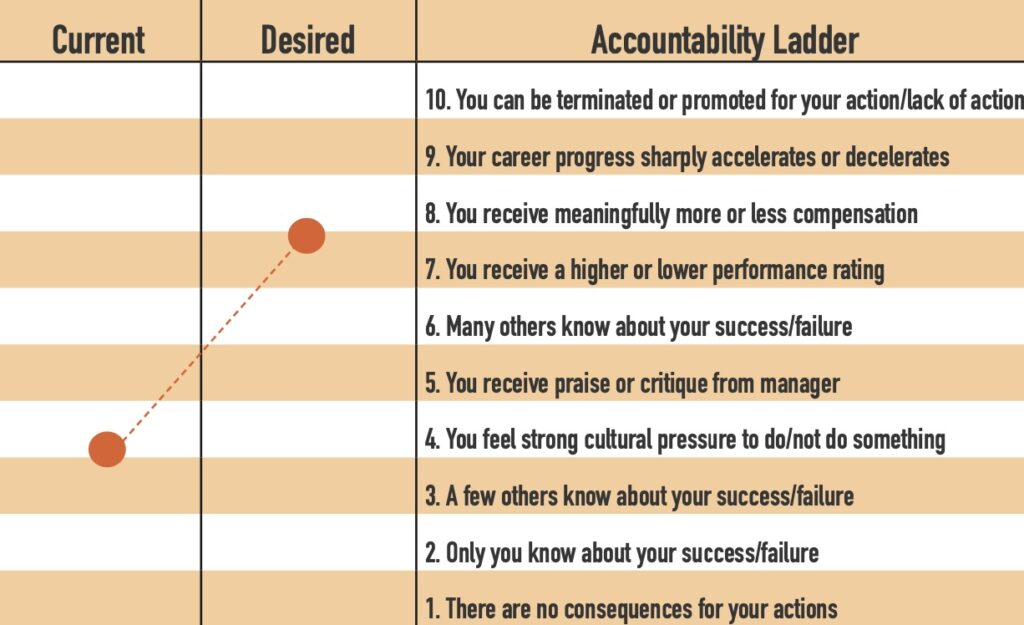
Implications
The science on engagement suggests that it has a smallish but still important relationship to organization performance. That relationship should drive actions to ensure that individual managers are taking the actions typically related to higher engagement.
Accountability Recommendations
This is another “customer” measure that can only be measured by perceptions. We favor that:
- Managers must increase their team’s annual engagement survey results or maintain high engagement results: Every manager should have an annual goal, hardwired into performance review results, to increase their score from the prior year. This increase goal can be adjusted based on prior year’s results (i.e. results of 40% or below must increase by 5 points, results of 41% – 60% must increase by 4 points).
Using this accountability metric has the side benefit of ensuring that structured employee listening occurs on an annual basis.
About
This Report
The 2024 Accountability Report includes data from 90 responding companies around the world. We solicited responses through email and LinkedIn posts in September 2024.
Participants answered 13 questions about the level of current and desired accountability for managers to complete specific talent practices. The scale used was our Accountability Ladder from the article of the same name which is comprised of escalating levels of accountability. The ladder begins “No one knows if you have done something or not” and ends with “You are promoted or fired for your actions.”
This data gathering method introduces potential response biases. We don’t assume that the collective responses constitute a perfectly representative sample of the HR population. We believe the sample size, combined with the diversity of respon-dents’ company size and sector, helps to reduce bias that could fundamentally alter any of the re-port’s findings. All data was gathered without attribution to any individual, so no incentive existed to be other than honest in responding.
The Talent Strategy Group
The Talent Strategy Group helps the world’s premier companies, governments, foundations and non-governmental agencies transform human resources and their ability to grow talent. Our advisory services include HR strategy, organization design, HR leader assessment and HR process design, among others. Our education and development services are based at our Talent Management Institute, which is the world’s most popular executive education program on talent. We teach executives and HR leaders how to build better talent faster through our public and private programs.
We advise across sectors and geographies. We have deep consulting experience in consumer products, big food, technology, pharmaceutical and bio-pharmaceutical companies, medical devices, financial services and health care. We partner with private equity firms to assess and develop talent for C-suite roles.
Author
Marc Effron advises the world’s premier companies, foundations, governments, NGOs and not-for-profit organizations on their most critical talent issues. He co-authored the Harvard Business Review Publishing best-selling books One Page Talent Management, often referred to as the “talent management bible,” and 8 Steps to High Performance.
Marc co-founded the Talent Management Institute at the University of North Carolina with Jim Shanley. It has become the world’s most popular executive education program on talent.